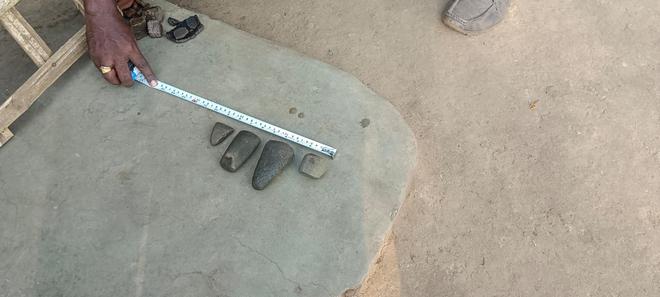In a rare find, Tamil Nadu State Archaeology Department officials stumbled upon over 100 megalithic burials inside Pattarakadu reserve forest (RF) atop Jawadhu Hills in Tiruvannamalai a few days ago.
Archaeologists said that it was the first time that they conducted a spatial survey in the hills after forest officials informed them about large-shaped granite structures that had been vandalised by trespassers in the RF. They have been abandoned and scattered atop the hillock.
During exploration of the inaccessible terrain, the archaeology team found a large number of megalithic burials and neolithic tools including small hand axes. The burial sites were found in remotely inhabited tribal villages, namely Keel Cheppili and Mel Cheppili near Jamunamarathur.
Each village has around 20 families, who are mostly migrants from the plains. “Earlier, we never explored the hills due to less habitation sites. However, the findings of megalithic burials gave us an opportunity for further research in the area. The findings indicate that there should have been some native inhabitants in the hills many centuries ago,” J. Ranjith, archaeological officer, Tiruvannamalai, told The Hindu.

A team comprising archaeologists and forest officials from Polur forest range trekked the hillock to reach the burial sites. A megalith is a large stone that has been used to construct a prehistoric structure or monument, either alone or together with other stones. Such sites are two types, namely those that have actual burial remains like dolmenoid cists or they are simply memorial sites like menhirs.
In Jawadhu Hills, archaeologists found that most of the megalithic burials were menhirs as they did not find any burial remains including things used by the deceased.
Each burial site, on an average, was 7.5 metres in diameter and 1.5 metres in height. Most burials, which are made of huge granite stones, are located in the south-west and north-east direction. Similar types of megalithic burials without remains were also found in Mallachandram (Krishnagiri) and Coimbatore region, the team said.
The team also found neolithic tools like small hand axes and pottery. These neolithic tools were being worshipped by locals in the village even today. Such practice is commonly found in north Arcot region and border areas like Tiruvannamalai, Krishnagiri, Dharmapuri and Salem region.
The team also found evidence for spatial surveys in the hills during British times as bench markings on some of the burials in English and modern Tamil were also noticed. The discovery has strengthened the resolve to conduct a full-fledged excavation in the hills to trace socio-economic and cultural origin of the inhabitants in the region, they said.







